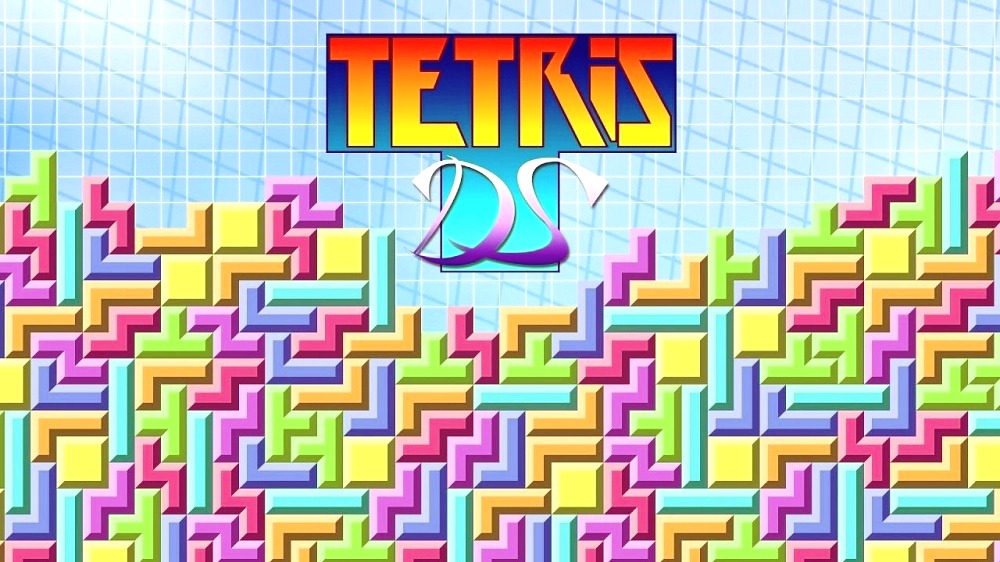

The goal is to push the pile down so it overlaps the opponent's danger line. Whenever two or more lines are cleared simultaneously, the player's side of the pile moves down, "pushing" the opponent's side upwards (The player's side is seen on the top screen, while the bottom screen shows the opponent's side upside-down, since the bottoms of both players' piles push against each other). Both players start with a 1x1 block floating in their field, and must place Tetriminoes on that to form a base (if a Tetrimino is dropped where it won't land on anything, it will simply fall out of the screen). Push mode is a competitive play mode for two players, or one person versus a CPU controlled opponent.

The screen may max out, but the player will lose points (up to a total of negative one hundred -100), however you can only finish this game and lose due to points, it is impossible to lose like a normal Tetris game. When playing Mission in the multiplayer function, it is the only mode where the player cannot 'lose'. Mission mode features a The Legend of Zelda backdrop. Other examples include clearing five lines while only receiving square Tetriminoes, or clearing three lines simultaneously with anything except a bar-shaped Tetrimino (in this case, using a bar Tetrimino will not clear the objective). An example of an objective is for the player to clear three lines with an "L" shaped Tetrimino. Failing to complete the objective in time will result in added blocks to the bottom of the pile. Also, completing an objective erases the bottom four lines of blocks from the playing field. A timer in the form of red hearts slowly disappears when a player completes the objective, the hearts fill anew and the player is assigned a new objective. The top screen displays your objective or "mission," while the bottom screen displays the playing field. Mission mode can be played competitively, or as a marathon to beat your own score. Another thing to note is that I-Spins, L-Spins, J-Spins, S-Spins, and Z-Spins are not recognized by the game. This means that actual T-Spins can be considered invalid, while moving a T-shaped tetrimino up a slope can be considered a T-Spin. One thing to note about rotations is that the final movement of a T-shaped tetrimino can be considered a T-Spin if it gained any height whatsoever. This "infinite rotation" rule was first seen in The Next Tetris and negates much of the difficulty that comes with the increased falling speed, so that a good player can clear hundreds of levels in an Endless Marathon. This means that the player can keep the piece in play indefinitely by rotating it consistently. However, a Tetrimino will not lock into place until the player does not move or rotate it for a set amount of time. The speed of the falling Tetriminoes increases noticeably faster than in other games, and at Level 18 and above, Tetriminoes are instantly on the ground the moment they appear. This does not work when pressed twice in a row (holding a piece, then attempting to hold the adjacent piece after). This allows the player to insert the tetrimino currently on the screen into a small box for future use, and will swap places with a piece after the button is pressed again.


The player is allowed to hold a Tetrimino by pressing L or R. Like most iterations of Tetris, Tetris DS's Standard mode has variations to the basic formula of the game. A small glitch in the game means that once the score has surpassed the maximum of 99,999,999 it is not saved in the records screen. Once exceeded these displays continue to show these maximum values. The highest visible score in Endless mode is 99,999,999, the highest visible level is 999, and the highest visible number of lines completed is also 999. In Endless mode, if the player reaches beyond level 20, the cycle of backdrops repeats. These backdrops share a song called "Rushed Tetris" which contained elements from Excitebike, Urban Champion, Devil World, and Duck Hunt. There are eventually other backdrops based on other games that appear later in the mode.Īll of the backdrops each have their own background music, with the exception of backdrops from levels 16 through 19. For the Mario backdrops, Mario advances through familiar levels as the player clears lines. One player Marathon mode ends at level 20 (after 200 lines), although Endless mode can be unlocked after finishing Marathon mode. 3 backdrop and several other Nintendo Entertainment System game backdrops. Standard mode features a Super Mario Bros. Standard mode can be played as a one player marathon, multiplayer with two players or one player versus a computer controlled opponent. This gameplay varies depending on how far you have gotten in the game. Standard mode plays much like traditional Tetris, although in Tetris DS, the play field is on the bottom screen, and a Nintendo themed gameplay clip loops on the top screen.


 0 kommentar(er)
0 kommentar(er)
